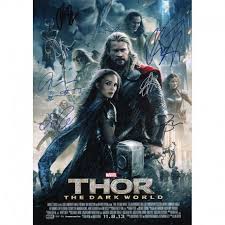
Millennia ago, the Dark Elves of Svartalfheim tried to turn the universe as dark as their home, using the Aether. Bor, father of Odin, stopped them with the armies of Asgard, but Malekith (Christopher Eccleston, the Ninth Doctor) escaped. The Asgard warriors found the Aether but it cannot be destroyed, so they hid it deep in a distant dimension. In the present day, Jane Foster (Natalie Portman) has been waiting for the return of her beloved Thor (Chris Hemsworth) for two years, but he is busy trying to establish peace in the Nine Realms.
Jane discovers an anomaly like the one that brought Thor to Earth and took him away. She is sucked into a wormhole. Thor learns from Heimdall (Idris Elba) that Jane has vanished from his sight. Thor returns to Earth just as Jane reappears; he brings her to Asgard and discovers that she had crossed paths with the Aether, and it had entered her body. Clearly, it is using her for its own purposes. Malekith attacks Asgard, seeking the Aether. Thor’s mother Frigga (Rene Russo) is killed. Thor and his friends wish to defy Odin by taking Jane away from Asgard, so they free Loki (Tom Hiddleston) from prison to aid in the escape.
The final confrontation with Malekith takes place at the Convergence, when the Nine Realms line up for crossing. Armies and monsters cross easily from realm to realm. Thor battles Malekith through the realms from portal to portal, and finally defeats him. In mid-credits, Thor’s friends Volstagg (Ray Stevenson) and Sif (Jamie Alexander) take the Aether to the Collector Benicio del Toro), to keep it far away from the Tesseract in Asgard—both contain Infinity Stones—but as they leave, the Collector gloats: one down, five to go. At end-credits, there are still alien monsters romping through England.
This movie has garnered criticism from fans, though I’m not sure why. Some have said there was too much humour and Marvel had lost its way. On the other hand, some have said it was too dark—hello, it’s The Dark World—which is the opposite of the first criticism. There were indeed some problems with the script, so Joss Whedon was flown to London to re-write three scenes that weren’t working, and if that’s where the humour came from, which seems to be the case, I’ve got no problem with that.
The Marvel Cinematic Universe is a varied collection, every hero appearing in a different style of movie. Iron Man films are heavy on SF technology (and humour). Spider-Man movies are all superhero-coming-of-age movies, with a hearty dose of teen angst. Captain America is all about patriotic ideals and training, the Hulk all about anger and tragedy, and the Guardians of the Galaxy are living in an exotic fantasy adventure like Star Wars or the Voyages of Sinbad. Well, the Thor movies are about set design. There is a particular flavour to the architecture, the costumes, and the weapons—part medieval, part science-fiction. Clarke’s Third Law—any sufficiently advanced technology is indistinguishable from magic—is a kind of mantra for these films.
We accept Thor’s hammer as we accept Iron Man’s armour, Captain America’s vibranium shield, or for that matter, the Jedi lightsabre. Amid Thor’s derring-do and glib remarks, with the world or the universe in peril, we love to see the fairy-towers, monumental throne-rooms, the orc-like armies, the glowing force-field citadels, and the weapons that resemble medieval pikes and broadswords, but shoot electricity or lasers. Most action movies climax with a chase amid city traffic, across the rooftops, or through mountainous cloudscapes, but Thor pursues the Dark Elf Malekith through portal after portal, vanishing and re-appearing in thin air, sinking through the earth and falling from the sky of nine different planets in nine different dimensions. It’s a hell of a chase.
